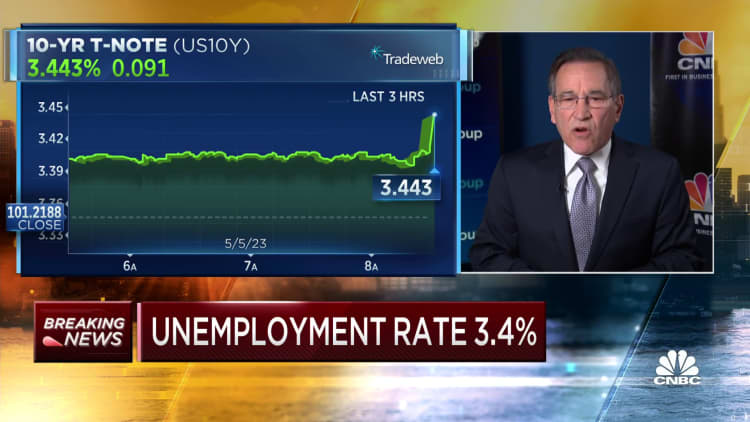
Job growth fared better than expected in April despite bank turmoil and a decelerating economy, the Labor Department reported Friday.
Nonfarm payrolls increased 253,000 for the month, beating Wall Street estimates for growth of 180,000, according to the Bureau of Labor Statistics.
The unemployment rate was 3.4% against an estimate for 3.6% and tied for the lowest level since 1969. A more encompassing number that includes discouraged workers and those holding part-time jobs for economic reasons edged lower to 6.6%.
Average hourly earnings, a key inflation barometer, rose 0.5% for the month, more than the 0.3% estimate and the biggest monthly gain in a year. On an annual basis, wages increased 4.4%, higher than the expectation for a 4.2% gain. Both numbers raise the chances that the Federal Reserve could decide to raise interest rates again in June, though markets were only pricing in a small probability following the jobs report.
"
Wall Street opened sharply higher following the jobs news, with the Dow Jones Industrial Average gaining nearly 400 points, while Treasury yields jumped as well. The move higher followed a strong earnings report from Apple and a powerful rebound in banking stocks.
"It is encouraging to see a strong jobs report amid recession concerns, instability in the banking sector and ongoing layoffs," said Steve Rick, chief economist at CUNA Mutual Group. "We are hopeful the continued strength of the jobs market and signs of slowing inflation will ease market volatility in the coming months."
Professional and business services led the job gains with an increase of 43,000. That was followed by health care (40,000), leisure and hospitality (31,000), and social assistance (25,000).
Despite serious banking industry troubles, jobs in finance increased by 23,000. Government hiring rose by 23,000.
April's upside surprise was offset by sharp downward revisions in previous months. March's count was slashed to 165,000, down 71,000 from the initial estimate, while February fell to 248,000, a reduction of 78,000. Also, the household survey, which is used to calculate the unemployment rate, showed a softer total jobs gain of 139,000.
"The best you can say from today's report is that job growth is slowing when looking at the average over the past few months," said Matt Peron, director of research at Janus Henderson Investors. "However, wages were stubbornly high and that's a key aspect of the report for the Fed and markets. Our concern is that policy rates will have to remain high which could pressure earnings and equity multiples."
The unemployment rate tied a record low going back to May 1969. The jobless level for Blacks fell to a fresh record 4.7% and declined to 4.4% for Hispanics while holding at 2.8% for Asians. The rate for adult women was unchanged at 3.1%.
The labor force participation rate was unchanged at 62.6% while the labor force edged lower to 166.7 million.
Friday's report comes amid persistent troubles in the banking industry, particular midsize regional institutions that have been hit by runs on deposits and worried investors who have sent share prices tumbling.
The economy also appears to be slowing toward a possible recession later in the year. Gross domestic product increased just 1.1% in the first quarter, largely on an inventory drawdown though there have been signs that consumer spending is weakening. Credit card spending, for instance, has declined 0.7% from a year ago, according to Bank of America.
Despite the bank troubles and recession fears, the Federal Reserve this week raised its benchmark interest rate another quarter percentage point, taking it to its highest level since August 2007.
Fed Chairman Jerome Powell acknowledged that higher interest rates were pressuring households, though he noted that the labor market has remained strong. He added that the economy "is likely to face further headwinds from tighter credit conditions."
The central bank is striving to get inflation down to a 2% annual level, though it is well above that now. One measure, the consumer price index, shows inflation running at a 5% annual pace.
Rising wages have helped pressure prices. Powell said a 3% annual wage gain is probably consistent with the Fed's 2% mandate.


